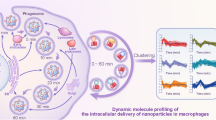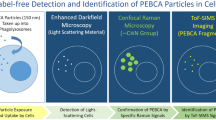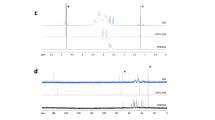Abstract
Ru(bpy)3@SiO2-COOH and Ru(bpy)3@SiO2@CD47-peptide nanoparticles (NPs) with fluorescent and mass spectrometric properties were designed and synthesized as the models of drug-nanocarriers. Their phagocytic internalization could be quantitatively measured using more sensitive inductively coupled plasma mass spectrometry (ICPMS) (102Ru) versus traditional laser confocal scanning microscope (λex/em = 458/600 nm) for the first time. Modification of a self-signal trigging CD47-peptide on the NPs’ surface decreased internalization by 10 times, (2.79 ± 0.21) × 104 Ru(bpy)3@SiO2-COOH and (0.28 ± 0.04) × 104 Ru(bpy)3@SiO2@CD47-peptide NPs per RAW264.7 macrophage (n = 5). The alkynyl-linked CD47-peptide allowed us to quantify the number (2412 ± 250) of CD47-peptide modified on the NP and the total content (5.14 ± 0.25 amol) of signal regulatory protein α (SIRPα) on the macrophage by measuring the clickable tagged Eu using ICPMS. Furthermore, the interaction between CD47-peptide and SIRPα as well as the changes of the remaining free SIRPα during the internalization process of Ru(bpy)3@SiO2@CD47-peptide NPs were quantitatively evaluated, providing direct experimental evidence of the longspeculated crucial CD47-SIRPα interaction for drug-nanocarriers to escape internalization by phagocytic cells. Remarkable difference in the internalization ratio of 12.3 ± 4.8 of Ru(bpy)3@SiO2-COOH NPs and 4.3 ± 0.5 Ru(bpy)3@SiO2@CD47-peptide NPs with and without the protein corona indicated that CD47-peptide still worked when the protein corona formed. Not limited to the evaluation of the NPs studied here, such a fluorescent and mass spectrometric approach is very much expected to apply to the assessment of other drug-nanocarriers designed by chemists and before their medical applications.

Graphical abstract





Similar content being viewed by others
References
Davis ME, Chen ZG, Shin DM. Nanoparticle therapeutics: an emerging treatment modality for cancer. Nat Rev Drug Discov. 2008;7:771–82.
Petros RA, DeSimone JM. Strategies in the design of nanoparticles for therapeutic applications. Nat Rev Drug Discov. 2010;9:615–27.
Wong PT, Choi SK. Mechanisms of drug release in nanotherapeutic delivery systems. Chem Rev. 2015;115:3388–432.
Wilhelm S, Tavares AJ, Dai Q, Ohta S, Audet J, Dvorak HF, et al. Analysis of nanoparticle delivery to tumours. Nat Rev Mater. 2016;1:16014–25.
Tenzer S, Docter D, Kuharev J, Musyanovych A, Fetz V, Hecht R, et al. Rapid formation of plasma protein corona critically affects nanoparticle pathophysiology. Nat Nanotechnol. 2013;8:772–81.
Cedervall T, Lynch I, Lindman S, Berggård T, Thulin E, Nilsson H, et al. Understanding the nanoparticle-protein corona using methods to quantify exchange rates and affinities of proteins for nanoparticles. Proc Natl Acad Sci U S A. 2007;104:2050–5.
Geissmann F, Manz MG, Jung S, Sieweke MH, Merad M, Ley K. Development of monocytes, macrophages, and dendritic cells. Science. 2010;327:656–61.
Walkey CD, Chan WCW. Understanding and controlling the interaction of nanomaterials with proteins in a physiological environment. Chem Soc Rev. 2012;41:2780–99.
Santos SN, Reis SRR, Pires LP, Helal-Neto E, Sancenόn F, Barja-Fidalgo TC, et al. Avoiding the mononuclear phagocyte system using human albumin for mesoporous silica nanoparticle system. Microporous Mesoporous Mater. 2017;251:181–9.
Patel PC, Giljohann DA, Daniel WL, Zheng D, Prigodich AE, Mirkin CA. Scavenger receptors mediate cellular uptake of polyvalent oligonucleotide-functionalized gold nanoparticles. Bioconjug Chem. 2010;21:2250–6.
Walkey CD, Olsen JB, Guo H, Emili A. Nanoparticle size and surface chemistry determine serum protein adsorption and macrophage uptake. J Am Chem Soc. 2012;134:2139–47.
Howard JC, Florentinus-Mefailoski A, Bowden P, Trimbleb W, Grinstein S, Marshall JG. OxLDL receptor chromatography from live human U937 cells identifies SYK(L) that regulates phagocytosis of oxLDL. Anal Biochem. 2016;513:7–20.
Vance DT, Dufresne J, Florentinus-Mefailoski A, Tucholskaa M, Trimble W, Grinstein S, et al. A phagocytosis assay for oxidized low-density lipoprotein versus immunoglobulin G-coated microbeads in human U937 macrophages. Anal Biochem. 2016;500:24–34.
Fang RH, Jiang Y, Fang JC, Zhang LF. Cell membrane-derived nanomaterials for biomedical applications. Biomaterials. 2017;128:69–83.
Blanco E, Shen HF, Ferrari M. Principles of nanoparticle design for overcoming biological barriers to drug delivery. Nat Biotechnol. 2015;33:941–51.
Barclay AN, van den Berg TK. The interaction between signal regulatory protein alpha (SIRPα) and CD47: structure, function, and therapeutic target. Annu Rev Immunol. 2014;32:25–50.
Matozaki T, Murata Y, Okazawa H, Ohnishi H. Functions and molecular mechanisms of the CD47-SIRPa signalling pathway. Trends Cell Biol. 2009;19:72–80.
Oldenborg PA, Zheleznyak A, Fang YF, Lagenaur CF, Gresham HD, Lindberg FP. Role of CD47 as a marker of self on red blood cells. Science. 2000;288:2051–4.
Willingham SB, Volkmer JP, Gentles AJ, Sahoo D, Dalerba P, Mitra SS, et al. The CD47-signal regulatory protein alpha (SIRPα) interaction is a therapeutic target for human solid tumors. Proc Natl Acad Sci U S A. 2012;109:6662–7.
Rodriguez PL, Harada T, Christian DA, Pantano DA, Tsai RK, Discher DE. Minimal “self” peptides that inhibit phagocytic clearance and enhance delivery of nanoparticles. Science. 2013;339:971–5.
Rossi A, Kontarakis Z, Gerri C, Nolte H, Hölper S, Krüger M, et al. Genetic compensation induced by deleterious mutations but not gene knockdowns. Nature. 2015;524:230–3.
Bagwe RP, Yang CY, Hilliard LR, Tan WH. Optimization of dye-doped silica nanoparticles prepared using a reverse microemulsion method. Langmuir. 2004;20:8336–42.
Kolb HC, Finn MG, Sharpless KB. Click chemistry: diverse chemical function from a few good reactions. Angew Chem Int Ed. 2001;40:2004–21.
Yan XW, Luo YC, Zhang ZB, Li ZX, Luo Q, Yang LM, et al. Europium-labeled activity-based probe through click chemistry: absolute serine protease quantification using 153Eu isotope dilution ICP/MS. Angew Chem Int Ed. 2012;51:3358–63.
Hatherley D, Graham SC, Turner J, Harlos K, Stuart DI, Barclay AN. Paired receptor specificity explained by structures of signal regulatory proteins alone and complexed with CD47. Mol Cell. 2008;31:266–77.
Acknowledgements
We thank the financial supports from the National Natural Science Foundation of China (21535007, 21874112 and 21475108), the National Basic Research 973 Program (2014CB932004) and the National Science and Technology Basic Work (2015FY111400) as well as the Foundation for Innovative Research Groups of the National Natural Science Foundation of China (21521004) and Program for Changjiang Scholars and Innovative Research Team in University (PCSIRT, Grant IRT13036).
Author information
Authors and Affiliations
Corresponding author
Ethics declarations
Conflict of interest
The authors declare that they have no competing interests.
Additional information
Published in the topical collection New Insights into Analytical Science in China with guest editors Lihua Zhang, Hua Cui, and Qiankun Zhuang.
Publisher’s note
Springer Nature remains neutral with regard to jurisdictional claims in published maps and institutional affiliations.
Electronic supplementary material
ESM 1
(PDF 240 kb)
Rights and permissions
About this article
Cite this article
Liu, C., Yu, D., Ge, F. et al. Fluorescent and mass spectrometric evaluation of the phagocytic internalization of a CD47-peptide modified drug-nanocarrier. Anal Bioanal Chem 411, 4193–4202 (2019). https://doi.org/10.1007/s00216-019-01825-y
Received:
Revised:
Accepted:
Published:
Issue Date:
DOI: https://doi.org/10.1007/s00216-019-01825-y




